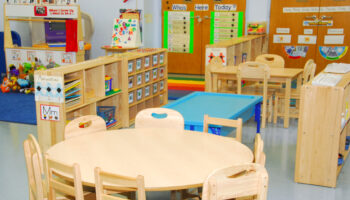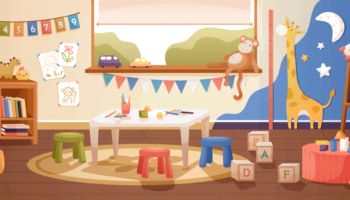Pam Schaffner
The assessment team in PA is often asked if they have any tips to make meeting quality standards easier. Since they have experiences visiting many programs in their professional careers, they have seen many programs employ strategies to make things easier, more efficient, and more effective. Implementing quality can be stressful or time consuming, but it is always worth it. So, this Q-T Corner moment aims at helping you along the way.
Installment #4
Room arrangement ideas:
The arrangement of a classroom is one of the most important parts of quality programming because the physical set-up of the classroom (the environment) can impact the usability of the space, the behavior of the children, the climate for learning, and even the mood of those using the space.
Room arrangement can be difficult due to many factors as well. These include (but are not limited to) the size of the room, the location of the doors (and emergency exits), the number of shelves, tables and chairs in the room, structural parts of the room such as pillars and L-shaped rooms, and even the location of the sink or electrical outlets.
Due to the challenges of setting up the classroom you have been given, there are a few tricks in order to make the space work for you.
Five big things to consider are: making things convenient, keeping noisy activities away from quiet ones, setting up interest centers so one type of play has its own space, allowing enough space in various interest centers, and of course, do not block exit doors.
Let’s talk about each one and how we can begin to look at room arrangement.
- Convenience: Does your classroom have a sink? If yes, place your art area, sand and water tables, and eating tables close to it. Wouldn’t it be nice to not have to send children across a whole entire room to wash their hands after painting? If the sink is right there, less mess to clean.
- Quiet/Noisy: What are noisy activities and what are quiet activities within your room? Noisy areas are typically block play, music, and dramatic play. Quiet areas are usually cozy areas and book areas (often seen as one area). To separate the two, put the cozy/book area(s) in one corner of your room and the other materials in the opposite corner. Materials such as art, math, science, fine motor, writing, etc. are materials to store in between these quiet/noisy areas.
- Interest centers: To promote productive play, organization of materials, and ease of clean up, classroom toys and materials are best organized into interest centers. An area set up as an art interest center, for example, includes materials for art. Therefore, materials for art and only art are included in a specific area of the room. If materials other than art materials are in the area, it is not an interest center. For example, what would happen if you included the puppets in the art area? Wouldn’t you be promoting them to paint on them or cut them with scissors? If this is not your goal, include only materials for art in the art area, blocks in the block area, etc.
- How much space does each interest center need? This depends on many factors. The size of your room can be a factor to consider. The interests of the children are also a factor. For example, if you constantly have a waiting list or conflicts over turns in the block area but not the adjacent art area, can you decrease the size of the art area and increase the size of the block area to allow more children to play without crowding? Do you have additional block materials to add as well to decrease competition over materials in the area (materials for 4 children rather than 3)? Consider the popularity of areas that children enjoy as well as the quantity of materials available for an interest center prior to arranging the room and be open to making changes as their interests change. If more space is needed for an area, consider whether you have an area for circle time that is large and accommodates everyone. Is the circle area a part of an interest center or is it an unused space during play time? If circle time happens in the largest interest center (usually blocks or dramatic play), then the whole space is being used during play. Also, make sure that there are some pathways from one interest center to another to lessen disruptions to play (for example, not walking through the block area to get to the art area).
- Do not block exit doors! Make sure that when you arrange a classroom, there is a clear path to the exit doors and that few if any toys would be used on the floor in front of those doors. Keep the area clean because safety is of utmost importance.




